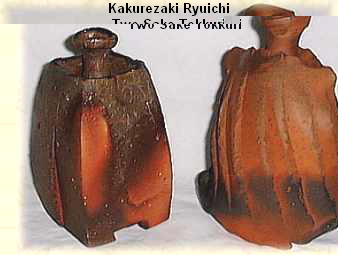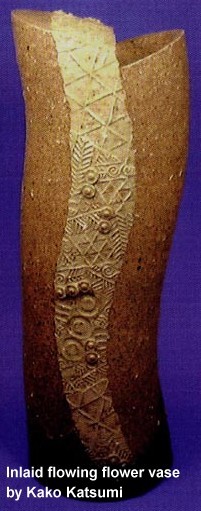|
Article for Asian Art Newspaper
www.asianartnewspaper.com
February 2002, by Robert Yellin
RESHAPING JAPAN'S CERAMIC SCENE
Click photo to jump directly to artist info.

Kakurezaki Ryuichi, Mihara Ken, Miwa Kazuhiko, Kako Katsumi
What's Happening in Today's Ceramic Scene
Japanese pottery is an insular world that dates back to the beginning of mankind's first ceramic vessel and one that flourishes to this day in flair and color. Perhaps no other land has the depth, variety, and cultural support of pottery as Japan. From the dining table with its lowly chopstick rests or simple teacup, to the Way of Tea room with its calm tea bowls or sculptural water jars, fine pottery graces the passing moments for many Japanese, and non-Japanese alike. It's a small blessing to live with such works, much in the vein of Blake's "To see a world in a grain of sand, heaven in a wild flower, hold infinity in the palm of your hands, and eternity in an hour." To gaze upon and use fine Japanese pottery raises one's aesthetic level; of that I am sure.
Volumes have been written about Japanese pottery starting with ancient Jomon wares up through the late 20th century, but not much has been written since. I might add that although most of the individual giants of the 20th century are known in the west, such as Rosanjin, Hamada Shoji, and Tomimoto Kenkichi, there are many, many more greats that have never been shown outside Japan. One of the reasons is that their work was never written about or promoted by western critics or dealers. Some names that come to mind were part of the Mingei Movement, like Tsuneji Ueda and Murata Gen, while others were part of more ancient traditions, such as Bizen's Yozan Isezaki or Nishimura Shunko. I suspect that if there had been an English-speaking voice back then for them, such as Leach's or Cardozo's, they would have found a receptive audience.
Yet that is in the past, and even though their works can still be discovered and appreciated even today, the question I'd like to pose and explore in this brief article is what is happening today in Japan.
It is a complex question for the ceramic world here is so dynamic, so deep. It takes a regular viewing over years to really grasp the situation. What I see is a shift amongst the way younger potters who are making a name for themselves approach clay. It can be said in one word; form.
We see this in many classical traditions such as Hagi and Bizen where the ancient forms have become just that for many a young wheel spinner -- aged and worn out. For younger artists with modern senses these age-old forms are a source of inspiration and many do master the technical aspects of creating and firing, for example, a standard tsubo (jar). But it isn't enough for many. In this day and age where many younger Japanese have blond hair, making an individual statement has become quite important. The old proverb of the "nail that sticks out gets pounded down" has been thrown by the wayside and sticking out makes it easier to be noticed.
The beginning of this line of thinking can be traced back to the late 1940s with the founding of the Kyoto avant-garde group Sodeisha. Yagi Kazuo, Suzuki Osamu, and Yamada Hikaru were the founding members and their works continue to inspire many of Japan's younger potters today. Their sculptural forms rebelled against the Tea mentality of traditional Kyoto and in the beginning none of their works had functional intents.
Evidence of the continuing importance of sculptural forms in clay was most clearly seen at an April 2001 exhibition at the Ibaraki Ceramic Art Museum. Entitled Leaders of Contemporary Japanese Ceramics it featured the works of twenty artists who are, for the most part, already established artists.
Highlighted in the exhibition were Kyoto's Akiyama Yo, Rokubee KiyomizuVlll, Tatsusuke Kuriki, Asuka Tsuboi, Fukami Sueharu, and Kichizaemon Raku XV, demonstrating the continuing importance of Kyoto's trendsetting ways (see above link for photos of their work).
Others shown were Kasama's decorative Morihiro Wada, Tokyo's kitschy Nakamura Kinpei and Tokoname's great Ryoji Koie, the latter being a monumental figure and teacher.
Other recent exhibitions that explored form were "Primitivism" in Contemporary Ceramics held in 1990 at the Shigaraki Ceramic Park; Contemporary Ceramics, 1950-1990 at the Aichi Prefectural Museum in 1993; and more recently New Expression in Porcelain: Developments in the 1990s in 1996 at the Crafts Gallery, The National Museum of Modern Art, Tokyo.
Form has found a new path in many ancient traditions as well, the aforementioned Bizen and Hagi being prime examples.
In the past, Bizen's foundation was first firing, second clay, and third form in terms of importance. That has been reversed in a sense owing in part to a lack of really fine Bizen clay. The second reason is of course the search for self-identity.
Two artists' works stand out and have helped reshape the Bizen and Hagi ceramic landscape. For Bizen that would be Ryuichi Kakurezaki, whereas Hagi has Kazuhiko Miwa. They have both essayed works using the ancient ways but with a fresh approach that has brought accolades from around the world.
Kakurezaki makes his work quite thick so that he can carve it into his desired forms. They are at times elegant and flowing while others are edgy and rough. Already we see Kakurezaki imitations, yet more than that he has freed the younger potters to allow them to concentrate on their own forms without being a slave to the Momoyama period (1568-1603) shapes that still abound in Bizen today, even after 400 hundred years. His work is highly sought after here and down the road a few decades his work will become the defining element for 21st century Bizen.
 |
The same can be said of Miwa's work. Unlike Kakurezaki, though, who came to Bizen from Nagasaki, the Miwa family is the most respected potting family in Hagi. It would have been quite the easy path for Kazuhiko to follow his father, Living National Treasure chadogu (tea utensils) expert Miwa KyusetsuXl, yet he chose a different wheel. Kazuhiko's work, like Kakurezaki's, is bold and fresh. Often embellished with gold and sometimes "wings," it takes off from the standard image of Hagi. The larger works are powerful, or refined small tea caddies with gold-tipped lids. The radical flower artist Nakagawa Yukio often does Miwa's intriguing flower arrangements.
Last year's grand prix winner of the prestigious Tanabe Museum Contemporary Tea Forms exhibition was Shimane-based Mihara Ken. His work is sharp with tense lines like that of 7th century Sueki wares. The large flower vessel shown here is bluish gray in color, and again it is the beauty of the form that attracts the senses. Without being overly showy, the work is full of a subdued personality that aptly matches a quiet Tea Room or a relaxing living room. Mihara is a potter who is also exploring form based on older traditions.
A much younger potter is Kako Katsumi (see photo below). Still barely known here and with a talent waiting to mature, he, too, is enraptured with form. Taking clues from the Seto veteran Kato Kiyoyuki, he places complex stamped patterns around his cylindrical or rounded organic forms.
 Now I'd like to add that there is a downside to all eyes on form only. First off, it can become so academic without any spirit, and that bothers me. Secondly, many younger potters just graduating from art school do not pay their dues in a traditional workshop and just become a ceramic artist from the word go. Most will fail, especially in these pinched times. It would serve many of these younger artists well to do three or five years in a shokunin's (craftsman's) workshop to learn of the heart from where the Japanese ceramic world beats. It is not from the artsy galleries found in fashionable Tokyo districts such as Hiroo or Aoyama, but in the rural areas where the older ways are slowly dying. Now I'd like to add that there is a downside to all eyes on form only. First off, it can become so academic without any spirit, and that bothers me. Secondly, many younger potters just graduating from art school do not pay their dues in a traditional workshop and just become a ceramic artist from the word go. Most will fail, especially in these pinched times. It would serve many of these younger artists well to do three or five years in a shokunin's (craftsman's) workshop to learn of the heart from where the Japanese ceramic world beats. It is not from the artsy galleries found in fashionable Tokyo districts such as Hiroo or Aoyama, but in the rural areas where the older ways are slowly dying.
In that unfortunate passing a large slice of Japan's artistic heritage is lost too. It is the challenge for any artist to explore ways to find their own voice amidst traditions (particularly in Japan's case) that often stretch back centuries. Just like the Sodeisha founders who have all passed on, the youth of today are not only searching for themselves in clay, they are also defining in which direction the wheel will spin for contemporary Japanese pottery, and society as well. Let's hope it turns in harmony with the past, which is so relevant for the present, showing us inspired creations behind the exploring minds that create today's ceramics; I have introduced only four; there are many more!
Copyright 2002
Robert Yellin |